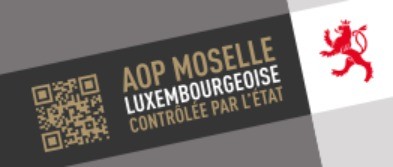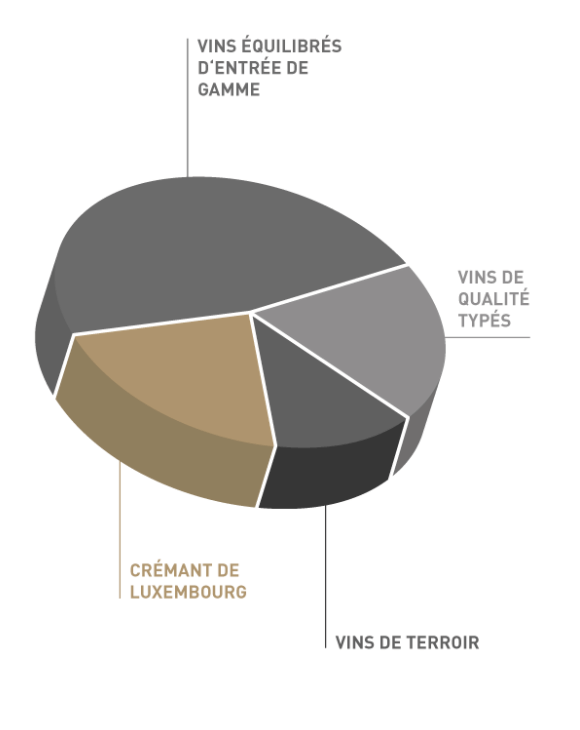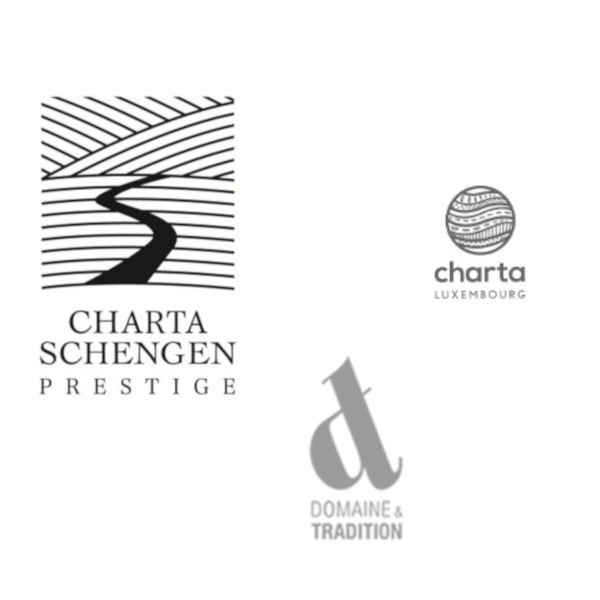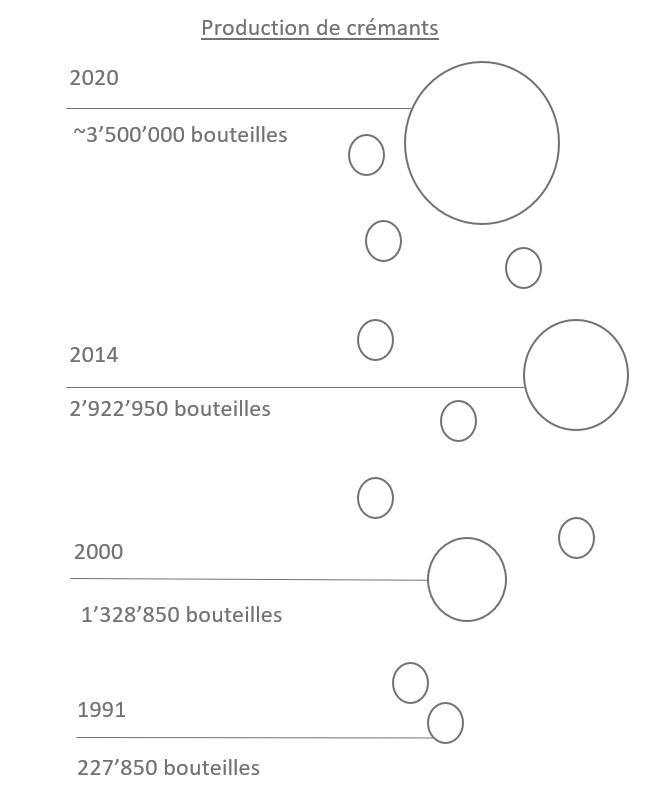© VinsLux-primaLu Sarl
PDO – Luxembourg Moselle
The main feature of the “Protected Designation of Origin – Moselle Luxembourgeoise” is that it is based on the internationally recognized principle of origin. Until then, the National Brand system was applied to Luxembourg wines. It had been created in 1935 and since then attested to the origin and quality of the product. From the start, the National Brand pursued two goals:
1. Encourage winegrowers to produce quality wines, in order to obtain a better price.
2. Allow consumers to realize, thanks to the Marque Nationale label, that they are buying a quality product.
The wines were graded on a 20-point scale by analytical examinations carried out at the viti-vinicultural institute. However, this did not take returns into account and the points system was not very transparent. The wines had to have a minimum of 12 points to obtain approval. Wines with more than 16 points were classified as “Premier Cru” and those with more than 18 points as “Grand Premier Cru”.
The national brand was replaced in 2014 by the “AOP – Moselle Luxembourgeoise”.

The objectives of the “AOP – Moselle Luxembourgeoise” are the same, but the way to achieve them is different. The “quality in the glass” is replaced by the original principle. The closer you get to the top of the quality pyramid, the more the terroir should be perceptible. The PDO is thus a guarantee of overall quality for the consumer, since all the production phases must also be carried out in the geographical area concerned.
From a wine-growing point of view, the terroir describes the entire natural environment of the vineyard, with its many interactions. It therefore encompasses not only the soil of the original vineyard, but also the complex interrelation between soil, topography, climate and human influence (e.g. type and style of winemaking)
Wines marketed under the protected geographical appellation “Moselle Luxembourgeoise” must fulfill the clauses of the “PDO – Moselle Luxembourgeoise” specifications and undergo a chemical and sensory analysis. It is only under these conditions that they will be able to bear the name “Moselle Luxembourgeoise”. On the affected bottles must appear a label with the state certificate.

The different categories:
LOCATION: Local wines (exceptional product)
The local wines come from the best vineyards of the Luxembourg Moselle. Renowned localities are strictly delimited. Here, the quality of a wine is determined by the terroir, therefore by its origin. The vineyard, low yields, manual selection and management close to nature are just some of the criteria that determine the excellent quality of these wines.
COTEAUX DE: Typical quality wines (high quality product)
The hillside wines are typified according to the grape variety and the region. These quality wines come from renowned vineyards in the cantons of Grevenmacher or Remich, and therefore represent two different types of soil: limestone (canton of Grevenmacher), Keupérien marl (canton of Remich). Hand-harvested grapes, low yields and careful vinification make this origin a real taste event.
CÔTES DE: Entry-level balanced wines (standard product)
Wines with the designation of origin “Côtes de” are harmonious entry-level wines that are very convincing. Their fruity and light character makes them a simple pleasure, to be enjoyed every day. The yield limitation for all grape varieties is a maximum of 100 hectoliters per hectare, with the exception of Elbling and Rivaner, for which it is 115 hectoliters per hectare.
CRÉMANT DE LUXEMBOURG
Aromatic grapes accompanied by refreshing acidity form the basis of this quality sparkling wine. With the selection of grape varieties, the blending in cuvée and the rest on the lees, we obtain unique products which give Crémant de Luxembourg an unforgettable taste experience.
Some traditional mentions enrich the nomenclature of PDO wines:
– Late harvest The wines with this mention are still, white and sweet wines. They are harvested through a rigorous selection of grapes by late manual harvest. The grapes are thus at an advanced physiological ripening with the presence of noble rot giving the wine characteristic aromas of honey, dried fruit or caramel.
– Straw wine The healthy and ripe grapes are dried and aerated for a minimum of 2 months, either on a bed of straw or a suitable material, or by suspension. A straw wine can only be made from a few grape varieties (Auxerrois, Pinot Blanc, Pinot Gris, Riesling and Gewürztraminer).
– Ice wine The grapes have frozen naturally and are harvested by hand when the outside temperature is below -7°C. The grapes are directly pressed to obtain a must with a high sugar content. Ice wine can only be made from Pinot blanc, Pinot gris or Riesling grapes.
– Premier Cru and Grand Premier Cru are reserved for white wines whose basic yields are fixed at 85 hl and 75 hl per ha respectively. Only certain grape varieties are allowed such as Rivaner (only in terms of 1er Cru), Sylvaner, Auxerrois, Pinot Blanc, Pinot Gris, Riesling, Chardonnay, Muscat-Ottonel and Gewürztraminer (which are either 1er Cru or Grand 1er Cru depending on the yield).
CHARTER WINES
Domaine et Tradition, Charta Schengen Prestige and charta.privatwënzer are initiatives dedicated to the production of extraordinary wines. First-class vineyards, planted on a slope or on a terrace, strict regulations, a limited yield and strict controls are the conditions that must be fulfilled in order to be able to market charter wines under the logo.


Source : PDO Luxembourgish Moselle
Crémants
The name “Crémant” can only be used for quality sparkling wine, white or rosé, with a protected designation of origin, if:
– the grapes are harvested manually
– the wines are made from must obtained by pressing whole or destemmed grapes
– the quantity of must obtained does not exceed 100 liters for 150 kilograms of grapes
– the cuvée was made sparkling by a second alcoholic fermentation in the bottle
– the cuvée has been continuously on the lees for at least nine months in the same company
– the sparkling wine was separated from the lees by disgorging
– the maximum sulfur dioxide content does not exceed 150 mg / l
– the sugar content is less than 50 g / l
From the 2021 vintage:
Wines, sparkling wines as well as crémants that will have followed the criteria of the PDO specifications and that will have been controlled will be able to put the mention: “Appellation d’Origine Protégée – Moselle Luxembourgeoise” with the label and the medallion on their bottles.
The medallion is either monochrome or as shown in the image.

